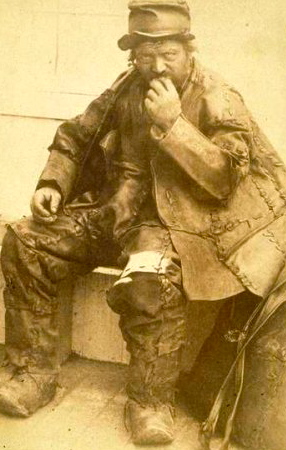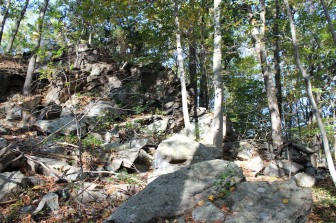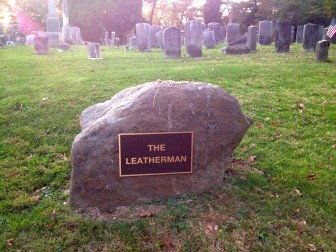“His story died with him, as he so obviously wished, leaving only a haunting memory, of a strange lonely figure, to posterity and to God.” — Katherine Crissey Weed Comstock, New Canaanite, 1950
Halloween is approaching and New Canaanites are preparing for the throngs of costumed characters ringing doorbells with hopes of receiving treats at every stop—an appropriate time to look back at one of the area’s most unique and mysterious costumed characters, a man who knocked on New Canaan doors looking for handouts back in the mid- to late-19th Century.
For the figure known throughout history only as “The Old Leatherman,” the handouts meant more than satisfying a sweet tooth—they were for survival.

The Old Leatherman. Contributed photo
Accounts of the Leatherman first surfaced in the 1850s. A mysterious stranger wearing a 60-pound outfit made entirely of patched leather began appearing in lower Westchester County. His weathered, bearded face partially obscured by a leather hat, the Leatherman gained notoriety among residents alarmed at the sight of the vagabond, who on rare occasions spoke only French and a little broken English.
According to historian Dan DeLuca of Meriden, author of “The Old Leather Man: Historical Accounts of a Connecticut and New York Legend,” the Leatherman was at that time self-sufficient, despite living in nearby caves and rock shelters.
“In the very beginning he was taking care of himself, buying his own food, maintaining gardens in various locations, and harvesting and preserving food,” DeLuca told NewCanaanite.com. “He would take food and put them in different shelters to get through the winter. He didn’t beg for food, and for him it was a way of life.”
This way of life quickly changed for the Leatherman, as his fame grew.
“People would decide they would try to find out more about him, and there would be reports in newspapers about this street person walking through these different towns, all dressed in leather,” DeLuca said. “If he passed through your area, you would call him to your house and give him coffee or something to eat, because you were looking for information from him. He would accept your coffee or what you’d give him to eat, but he wouldn’t tell you anything about himself.”
Eventually the Leatherman’s celebrity grew to a point where he could be completely dependent upon the free handouts and invitations, as long as he made his presence known—never a problem for the silent, yet bold character. Starting in 1883, the Leatherman began a clockwise circuit that stretched 365 miles from New York State’s Hudson River Valley to central Connecticut and back again. His route was routinely completed in 34 days, and was so systematic that some could set their watches to it.
“Down in Naugatuck Junction, there was a train master who used to keep track of him, because he used to keep track of the trains,” DeLuca said. “The Leatherman had to go across the Naugatuck River, so he had to go across a bridge. Well, the train master started taking notes of when he saw The Old Leatherman go over the bridge, just as if he was a train. And he was keeping a chart on when he would return and how many days it would take him. It came down to every 34 days that he was coming back again across the bridge.”
The real reason for the Leatherman’s tight schedule was so that his benefactors knew when to prepare for his arrival with food, coffee and discarded leather that their gentle—yet intimidating—visitor could use to patch his outfit. The choice of using leather clothes is not clear—perhaps to provide protection against the elements and wildlife, or perhaps for its abundance in this area. That said, some imaginative newspaper reporters from Woodbury decided to use the outfit to write their own tale of the Leatherman’s origins, safe in the knowledge that the reticent traveler would never refute what they wrote.
A tale of lost love was devised, as the reporters identified the Leatherman as one Jules Bourglay of Lyons, France who had been spurned by the daughter of a leather magnate after losing a fortune in the leather business. Banished to the United States, the Leatherman was supposedly cursed to wander the land dressed in the material of his downfall.
“That story went on for years when he was alive, then when he died it continued on into legend,” DeLuca said. “It makes a great story, and no one was able to check it out.”
One longtime Ponus Ridge resident documented her own direct encounters with the Leatherman. Katherine Crissey Weed Comstock in January 1950 recounted in an essay published in the New Canaan Historical Society annual that the Leatherman was a “grotesque figure” who arrived “in the middle forenoon about every six or eight weeks, knock at our south door and ask by motions to his lips for food, and acknowledge his gratitude in the same way.”
“He had a routine route with certain places to stop and was never known to vary or to ask for food at any other house on the Ridge. As children we enjoyed the prestige it gave us and despite his unusual, almost terrifying appearance, felt no fear of him.”
Comstock’s Ponus Ridge house was located near enough to the Leatherman’s “New Canaan home”—at the base of a steep cliff once referred to as the “Watchtowers of the Noroton Valley.”

The “Watch Towers of the Noroton Valley”. Contributed photo
The cliff, located to the west of Weed Street and just south of present-day Parish Lane, was a local landmark, popular among children for native American arrowhead excavations. Large boulders that spilled down from the cliffs formed a natural shelter, and its proximity to the Noroton River provided a water source that was a common feature of all the Leatherman’s domiciles.
New Canaan resident Mike Mottolese is an ardent fan of local history, and has been specifically fascinated with the legend of the Leatherman for years.
“The wandering nature of this guy was always fascinating to me,” Mottolese told NewCanaanite.com. “I like the outdoors and love the fact that his spots are all in these fairly inaccessible locations that you have to hike to, that you have to discover.”
As coincidence would have it, Mottolese lives on Weed Street, just a short walk away from the location of the Leatherman’s New Canaan cave, now surrounded by a thick forest on what is—for the moment— one of the last undeveloped parcels of acreage in the area. (The land is now for sale.)

The Leatherman’s cave is said to be in this area below the cliffs. Contributed photo
“I didn’t realize his shelter was as close to my house as it was,” Mottolese said. “It’s neat to know that he could have passed by in my woods. Now that the leaves are thinning out I peek into the woods there and wonder if it’s all going to go away once they develop in there.”
The Leatherman continued his trek until 1889, when he was found dead in cave near Ossining, N.Y. His death certificate lists cancer and starvation as the cause of death. Buried in a pauper’s grave at the edge of Ossining’s Sparta Cemetery, the legend of the Leatherman continued to grow into myth.
Locals would dress up as the Leatherman for parades, prompting some to believe that he was still alive and roaming the countryside. Others would make pilgrimages to his gravesite at the side of an ever-growing Route 9, eventually marked with a gravestone that incorrectly identified him as “Jules Bourglay.”

The Leatherman’s grave. Contributed photo
Eventually, DeLuca’s research uncovered the myth and the Leatherman’s grave was exhumed and moved to a safer location within the cemetery and further away from the busy Route 9, replete with a new headstone that simply said “The Leatherman.”
Preparations were made to also get some DNA that might possibly, at long last, help identify the Leatherman. But when the old grave was dug up there was no body to be found—just a set of nails and the outline of the coffin that, like the body itself, had disappeared.
“It was a very acidic location,” DeLuca said. “The acid ate everything away, so they were not able to find any remains whatsoever. We took the soil and the nails and reburied it in the new location. But he’s still a mystery.”
A mystery that even now–more than a century after his death–continues to draw handouts from strangers.
“They leave two things on his grave–pieces of leather and pennies,” DeLuca said. “A lot of times what little kids used to do was to leave pennies on a fence post where the old Leatherman used to walk by. He would take the pennies and sometimes he would shine them up and place them back. Other times he would take the pennies and if there was a chicken coop nearby, he would take an egg, but leave a penny.”
I will be leaving pennies on my stoop this Halloween!
Leatherman is such a great story and you can find Leatherman caves all over CT and NY. Good job, Terry.
Years ago I used to lead a hike at Ward Pound ridge for a singles group and used to tell an abbreviated tale of the Leatherman and his lost love. This
brings me back….
Today, Saturday November 8th, I lead an annual hike at Ward Pound Ridge Reservation, Cross River from Michigan Road to the Leatherman’s Cave! Along the way I tell the Lore of the Leatherman. Mysterious intriguing stuff!